Basically, all of the links on this page are affiliate links. I receive a commission (at no extra cost to you) if you make a purchase after clicking one of the affiliate links below. Read our Affiliate Link Policy for more information.
A LiPo battery produces DC electric current. That means you need DC electric current to charge it. That’s the job of a LiPo charger: to make just the right voltage and current of DC electricity to charge the battery up safely. So where do you get the DC current from? You might think that’s the charger’s whole job, right? But it’s not, really. The charger’s job is to regulate the DC voltage and current so that it’s just right, not to create the DC current.
One way to get the DC current is if you’ve got another, bigger battery. For example, an automotive battery outputs 12v DC. Another option might be a solar panel that charges a 12v or 48v battery. That’s DC too. Feed that DC current into the charger and it regulates it down to the right voltage and current to charge the battery.
The problem comes when you want to plug the charger into a wall outlet. That’s AC, and the charger can’t just pass it to the battery. It has to be converted to DC. That’s the job of the power supply (PSU). Assuming that you want to plug your charger into the wall, you need a PSU in addition to the charger itself. Some chargers come with a built in PSU. These are known as AC/DC chargers. Some chargers don’t have a built in PSU. These are known as DC-only chargers. If you buy a DC-only charger, know that you can’t plug it into the wall. You will either need to run it off a DC power source like an automotive battery or solar system. Or you will need to buy a separate external PSU to let you plug it into the wall.
WELL, THAT’S STUPID
At first, this whole DC-only thing sounds stupid to a lot of people. Obviously, you’re going to want to plug the charger into a wall outlet at least some of the time! So why don’t chargers always have a built-in PSU?
A lot of hobbyists already own a PSU. For them, a built-in PSU is additional cost for no benefit. The built-in PSU adds weight and size, which means when you take the charger away from home and run it off a DC source, it’s bigger and heavier than it needs to be. The PSU is dead weight, if you’re not plugging into a wall outlet.
Finally, the built in PSU’s in most chargers are significantly smaller than the charger’s rated capacity if it’s run off an external PSU. This doesn’t HAVE to be the case, but it usually is. It doesn’t make sense to put a big, 1000 Watt PSU into a single charger. If you’re going to buy a PSU that big, you probably want to run multiple chargers off of it. And it’s going to be so huge that you wouldn’t want to carry it around when you take the charger on the road. A charger’s built in PSU might charge a battery in 2 hrs while an external PSU might charge the same battery in 30 minutes.
If you have a charger that you know you will always run off a wall outlet, then it should be AC/DC with built in PSU. If you have a charger that will sometimes run off a DC source and sometimes a wall outlet, it might make sense for it to be DC-only with separate external PSU. But if you can tolerate the additional size, weight, and cost, taking an AC/DC charger on the road can be very convenient, since you have the ability to plug it into a wall should the need arise.
CHARGER SPECIFICATIONS
The first specification you should check is the battery type and voltage that the charger can charge. All the chargers on this page can charge LiPo and Lithium Ion batteries. If you need to charge other chemistries like LiFePO4, NiMh, or Lead-Acid, you should check the product pages and manuals. Most chargers on this page charge between 1S and 6S batteries. It’s uncommon, but not impossible to find chargers that only go up to 4S though. And only a few chargers can charge higher voltages like 8S.
Next, check the charger’s Watt rating and Amp rating. The higher these numbers, the faster you can charge a battery. But keep in mind that you can only charge a battery so fast before it becomes unsafe. So as long as the charger’s Watt and Amp rating let you charge the battery as-fast-as-is-safe, you don’t need them to be any bigger. Watt and amp rating are a “whichever-comes-first” limitation. If either one is exceeded, the charging rate can’t go any faster. Which one you’ll hit first depends on whether you’re charging a big (high mAh) battery or a higher voltage (6S or 8S) battery.
The full math for calculating maximum charge rate has a lot of factors. But the short version is, take the battery’s mAh and convert it to amps. This is your 1C charge rate. This must be less than your charger’s Amp rating. 1C charge rate takes about 1 hr to charge the battery. If you double that number, that’s 2C, and it takes about 30 minutes to charge the battery. 3C takes about 20 minutes. 4C takes about 15 minutes. Charging at higher C rating is more dangerous, but some people do it. Official advice is that 1C charge rate is safest.
Multipy the your desired charge rate by 4.2 volts (assuming a LiPo that’s charging to 4.2 volts per cell). Multiply that by your cell count (e.g. 6S). This is your 1C charge rate in Watts. This must be less than your charger’s Watt rating.
For example: 1500 mAh 6S battery. 1500 mAh = 1.5 amps. Let’s say I’m going to live dangerously and charge at 4C. That’s 1.5 * 4 = 6 amps. Take 6 amps * 4.2v / cell * 6 cells = 151 watts.
For a more complete analysis of how big a charger you need, check out the detailed process in the above video.
Cheapest Worth Having
ISDT Q6 Nano
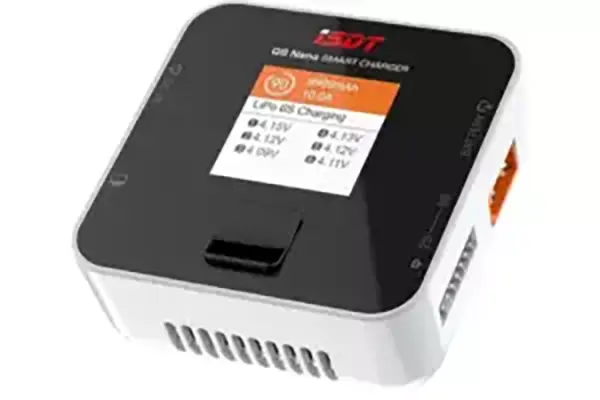
Although the Q6 Nano only puts out 200 watts, that’s still more than enough to charge a typical FPV battery as fast as you could safely want. It could do a blistering 8C (unsafe!!!) charge rate on a 1000 mAH 6S battery. Or charge a massive 8000 mAh 6S battery in about an hour at a safe 1C. Frankly, it’s probably MORE charger than you actually need.
The Q6 Nano is surprisingly inexpensive, especially given that ISDT has a reputation for decent quality and reliability. You’d struggle to pay less for an off-brand charger that might or might not die as soon as you took it out of the box. If the Q6 Nano is big enough to charge your battery as fast as you want, then it’s probably cheaper to just buy more Q6 Nanos than to buy a bigger, multi-channel charger.
You know that thing where a charger charges really quickly until it gets to lke 90% and then grinds to a halt and takes forever to finish? The Q6 Nano only has a 0.5 amp balance current, so it will be slower to finish a charge cycle if the pack is out of balance, especially on very large and high cell-count batteries, or if you’re parallel charging..
Another potential weakness of the Q6 Nano is that it can only charge a single battery at once. But given that it’s 1/2 to 1/3 the price of some other chargers on the list, you might just think it makes sense to buy a few.
GetFPV
RaceDayQuads
NewBeeDrone
Best for smaller fpv packs
ISDT P10

The P10 is a good choice if you want a dual-channel charger for charging typical FPV batteries of about 2000 mAh or less. It can charge two channels simultaneously at 250W or 10A per channel. This is a little better than the specs of the Q6 Nano, but not that much better. The P10 is more than 2x the price of the Q6 Nano. And the Q6 Nano can already charge smaller batteries faster than most people would consider safe. So from a pure price perspective, it’s better to buy two or three Q6 Nano than one P10. But having two channels in a single charger has some value. And the P10’s specs do beat the Q6 Nano by some margin. In addition to slightly higher power output, the P10 has much higher balance charge current, whihc speeds up the final stage of charging signfiicantly. So maybe the P10 is worth it to you.
RaceDayQuads
NewBeeDrone
Big, But Not Too Big
ISDT P20
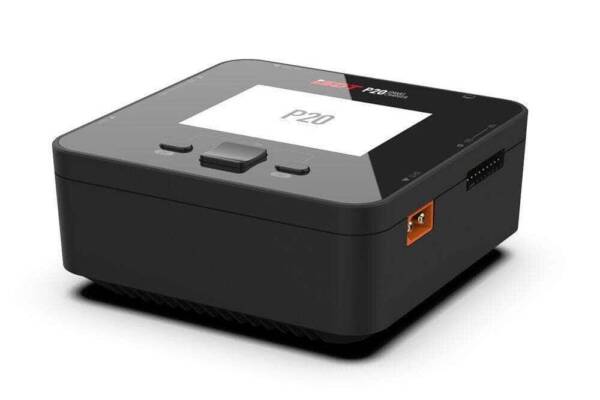
If you have larger batteries to charge but don’t need the massive 1000W output of the P30, the P20 is not-quite-half the price.
The ISDT P20 can charge a single channel at 500 watts and 20 amps. Or both channels simultaneously at a combined 1000 watts and 35 amps. The P20 has a healthy 1.5A balance current, so the final stage of charging large packs won’t take as long.
This charger can charge 8S batteries.
RaceDayQuads
NewBeeDrone
More Power For Bigger Batteries
ISDT P30
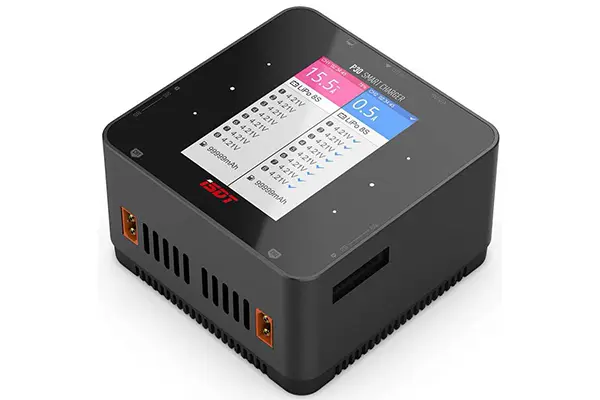
Let’s be clear: this charge is overkill for almost everybody. But if you need to charge large CineLifter batteries, or if you parallel charge lots of packs at once, then you need a charger that can push lots of amps and lots of watts. This is it. The ISDT P30 can charge at 1500 watts combined across both channels, or 1000 watts on a single channel, at up to 30 amps.
In addition to charging, the P30 can act as a DC power supply, from 2 to 30 volts with current limit from 1.0 to 5.0 amps. It won’t replace a proper bench supply, but it might come in handy.
Be aware that this charger requires higher input voltage to reach its full rated power. So you’ll want to look for a 24 volt, 1500 watt power supply if you intend to get the most out of it. The charger has a 60 amp input limit, which means you’ll get at most 720 watts out of it if you’re using a 12 volt power supply.
This charger can charge 8S batteries.
GetFPV
NewBeeDrone
My Daily Driver For Years
HOTA D6 Pro
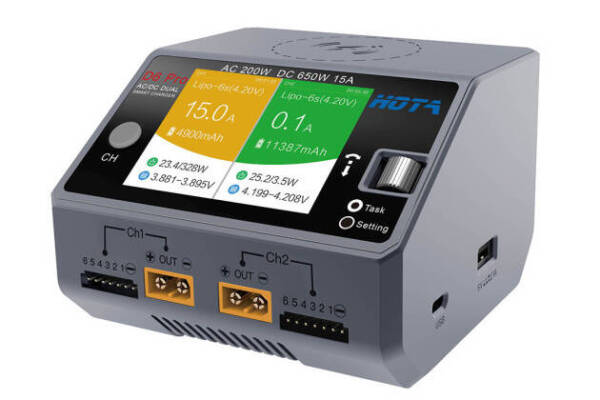
The D6 Pro has been my daily driver charger for literally years. I bought four of them in … 2020? Three of them are still going. One had a fuse blow on one of the channels. (I gave it to a friend who replaced the fuse and it’s still working.) So yeah … reliablity is one reason I love this charger. The other reason is that it’s the perfect balance of output power and compact size.
The D6 Pro has two channels (can charge two batteries at once). Output power on the built-in power supply is 200 watts and 15 amps total across both channels. That’s enough to charge one typical 5″ quadcopter battery at about 5-6C or two at about 2-3C each. That’s what I do when I’m on the road: pop the D6 Pro into my luggage and plug it into the wall at my destination. I can charge most of my packs as fast as I need to during the evening and be ready to go the next day. Even bigger packs like my 6000 mAh 6S battery for my airplane finish in a couple hours. Not ideal, but worth it for how small this thing is.
When I’m at home, I run the D6 Pro off my 1200W power supply. Then it’s rated for 325 Watts per channel (650 W total). This is perfect for quickly charging large batteries or parallel charging several batteries at a time.
The D6 Pro has generous 1.6A balance charge current, so it doesn’t slow down excessively at the end of a pack while balancing cells. It’s got USB output, but it’s just old-fashioned sl0w-charge 5v@2A USB. Nothing impressive. You can also wirelessly charge your phone by putting it on top of the charger.
I could spend more money on a bigger, heavier charger that gets the job done faster (that’s the S6, by the way). But why would I? The D6 Pro is the perfect charger for me.
RaceDayQuads
GetFPV
GEPRC
A challenger approaches...
ISDT K2 Zip
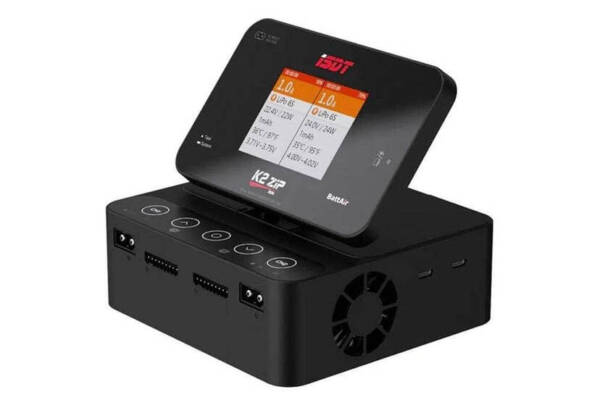
This charger might just be the new best all-round recommendation for a “typical FPV hobbyist”. It’s got the same “good enough but not super expensive” specs as the HOTA D6 Pro and the ToolkitRC M6D. Dual channels so it can charge two packs at a time. 200W total output power across both channels. The Zip has up to 20A output, compared to 15 for the others, but you’re more likely to hit the watt-limit first unless you’re charging lower-voltage batteries, so this isn’t likely to make a difference.
Several things make the K2 Zip stand out. First, it’s from ISDT, which is known for its build quality and reliability. It’s priced somewhere between the M6D and the D6 Pro. It’s got a lovely, colorful screen that flips up for easy viewing and down for storage. It’s got touch buttons, so there’s no physical control to break (but if you love physical controls, stay away). The Zip can also charge up to 8S batteries, while the others are limited to 6S. The K2 Zip can connect to and be controlled by a mobile app.
The M6D has 65W USB-PD while the K2 only has 50W. The M6D and the D6 Pro both have 650W rating when used with an external power supply, while the K2 Zip only has 500W. We think it’s not likely that these differences are enough to make-or-break the decision.
This charger can charge 8S batteries.
RaceDayQuads
GetFPV
First Charger On A Budget
ISDT 608AC
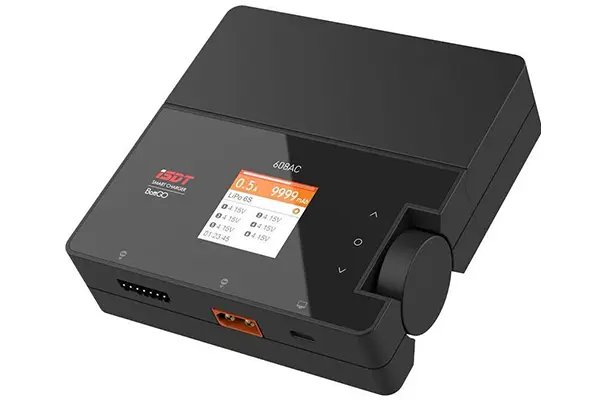
What if you didn’t have to decide between a bigger, heavier AC-input charger, and a lightweight, portable DC-input charger? That’s the point of the ISDT 608AC. It comes with a power supply that plugs into the wall (that’s the big thing hanging off the back). But you can easily detach the power supply and take just the charger with you, for charging off your car battery or another LiPo in the field.
The 608AC won’t win any awards for its output power: 60 watts and 8 amps is about what a beginner might need, but it’s not going to blast giant packs to full charge in the blink of an eye. That’s okay… beginners shouldn’t be blasting giant packs anyway.
GetFPV
RaceDayQuads
GEPRC
Like the D6, but bigger!
HOTA S6
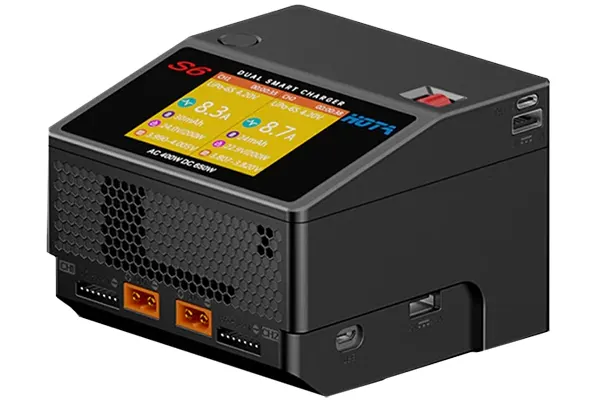
The HOTA D6 has been my personal favorite lipo charger for several years. So I’m thrilled that they’ve now released the S6, which is everything I loved about the D6, but even more power!
The D6 has a built in PSU that can run at 400 watts! It’s a massive amount of power especially given its small size. Compare to the ISDT K4, which has the same output (and costs $100 more). The D6 also has two USB 2A outputs and one 45 watt USB-C PD output.
The main question you have to ask if you’re considering the D6 is: do you really need this much power? If you’re only charging one or two typical FPV packs, you don’t. But if you charge very large packs for helis, planes, or cinelifters; or if you like to parallel charge 6-10 packs at a time, the HOTA S6 is the one for you.
GetFPV
RaceDayQuads
Rotor Riot
ToolkitRC Q6AC
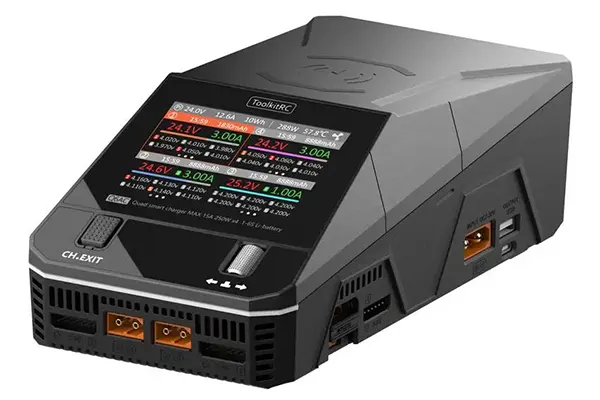
Many people think the Q6AC is the ultimate does-it-all charger. It’s got a built in power supply so it’s completely self-contained. Just plug it into the wall and go. It can charge up to four batteries at a time. It supports USB-PD up to 65 watts, so it can fast-charge your phone and run your portable soldering iron. It’s even got wirelss phone charging — just set your phone on top of it!
The Q6AC is pretty huge for a travel charger. But if you need to charge four batteries at the same time, you probably won’t find many solutions that are smaller. The real down-side of this charger goes back to its specs. It claims to support up to 1000 watts and 50 amps of charging, but that’s only if it’s powered from an external power supply. The built-in power supply can only do 100 watts and 15 amps per channel. That’s enough for about 2-3C charge rate on a typical 5″ mini-quad battery. But if you use larger batteries, you’ll be limited to lower charge rates. Any battery over about 4000 mAh 6S is going to charge at slower than 1C. Hey — that’s the safest thing to do anyway, right?
I always hesitate before I recommend ToolkitRC chargers. I have personally had two of them that had what I consider to be unacceptable defects. One died randomly while charging after just a few days of use. One came severely mis-calibrated out of the box. The latter case could have ruined batteries by over-charging them and/or even caused a fire. I’ve also asked some stores who sell ToolkitRC chargers, and some models of their chargers (but not the Q6AC) have very high defect/return rates. I know that I could just be unluckky, and there are plenty of people who rely on ToolkitRC chargers with no problem. But when a charger is responsible for not-burning-down-my-house, it’s easy to be gun-shy about even one or two such defects.
If you decide to buy the Q6AC, I suggest getting the Five33 edition. Evan Turner, the owner of Five33, assures me that he’s had no QC issues with that charger. He uses it personally. You would assume that the chargers sent to Five33 are the same as the ones sent anywhere else, just with a different color case. But maybe there’s something about Five33 that means they get the “good ones”.
Five33
RaceDayQuads
GetFPV
NewBeeDrone
Rotor Riot
Five33 M6DAC
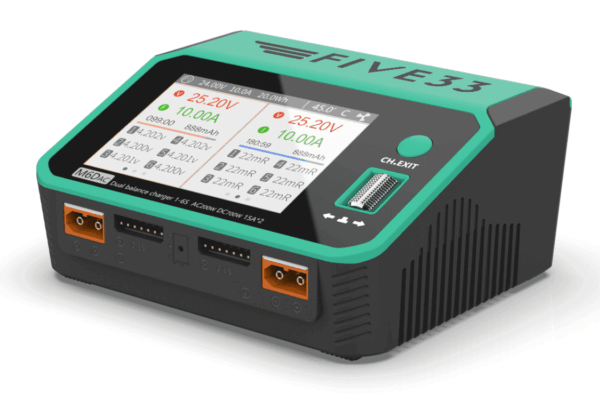
The M6DAC is a compact 2-channel LiPo charger with built in power supply. That sounds a lot like the HOTA D6 Pro, my daily driver. Let’s compare. 200 watts output power on the built-in PSU? Check. 15 amp limit? Check. 350 Watts per channel when used with external PSU? Check. They sound pretty identical!
The M6D has 65 watt USB-PD output, compared to the old-style slow-charging USB output on the HOTA. One point for the M6D!
If the price was the same, I’d take the HOTA every time, because HOTA has beeen almost completely bulletproof for me, whereas ToolkitRC has had some QC issues. I have personally had two of them that had what I consider to be unacceptable defects. One died randomly while charging after just a few days of use. One came severely mis-calibrated out of the box. The latter case could have ruined batteries by over-charging them and/or even caused a fire. I’ve also asked some stores who sell ToolkitRC chargers, and some models of their chargers (but not the Q6AC) have very high defect/return rates. I know that I could just be unluckky, and there are plenty of people who rely on ToolkitRC chargers with no problem. But when a charger is responsible for not-burning-down-my-house, it’s easy to be gun-shy about even one or two such defects.
But the Five33 version of the ToolkitRC has Evan Turner and his company, Five33, standing behind it. And that means something to me. He swears he’s got no particular issues with defective units or returns. And lots of racers use this charger as their go-to. And at least at the time I’m writing this, the M6D is about 2/3 the price of the D6 Pro. So maybe I’d buy the Five33 version of this charger specifically (but not the ToolkitRC version).
Five33
ISDT Air8
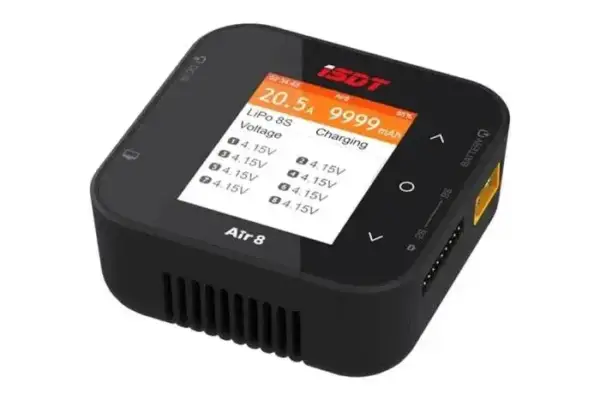
When I first started getting into 8S drones, I looked around for the lowest-priced 8S charger that I felt I could actually trust. This was it. The ISDT Air8 has specs. But that doesn’t really matter. Because you just want something — anything — that will charge your 8S battery at a reasonable rate and for a reasonable price. Ok … the specs matter a little. 500 Watts and 20 Amps. Are you happy? That’s actually pretty decent. You can charge up to a 14,800 mAh 8S battery at 1C!
One catch: you’ll need a 500W or higher external PSU. The Air8 doesn’t have a built-in PSU. But that makes it ultra-portable (as long as you have something to power it off of wherever you’re going).
Do you need even more power? The Q8 Max can do 1000W and 30A.
This charger can charge 8S batteries.
ISDT K4
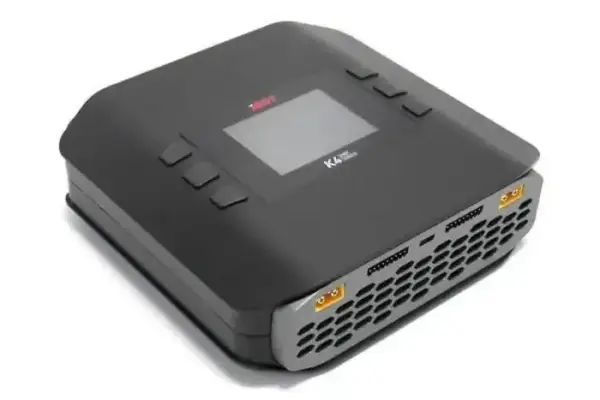
If you want the maximum output power from a charger with built-in PSU, this is it. The ISDT K4 can output 400W combined across its two output channels. This is perfect for fast-charging even large batteries or big parallel charging arrays. The K4 is a work-horse!
Most people who want to charge this fast will be using an external PSU. And if you were to use an external PSU, you could easily get 500-1000 watts out of several chargers on this page. But the K4 offers the convenience of a single package. Just plug in a power cable; plug it into the wall; and you’re ready to go.
Yes. Obviously more powerful chargers exist. We just think this is about the biggest one a “typical hobbyist” is likely to 1) need, and 2) be willing to pay for. For example, the ISDT X16 outputs 800W off its internal PSU and costs $800.
This charger can charge 8S batteries.
GetFPV
Why do Whoop battery chargers get their own section? Can’t you charge Whoop batteries with a normal lipo charger? Yeah, you can. But big lipo charges are made to charge one or two big batteries with high output power. Whoop chargers are made to charge a four to six tiny batteries at a time, and high output power isn’t needed since the packs are so small. A Whoop charger can run all night from a modest USB power bank or LiPo battery. They’re small and easy to take with you. On top of this, Whoop chargers are typically not too expensive, so the convenience of having a dedicated charger for your Whoop packs is easy to take advantage of.
WhoopStor V3
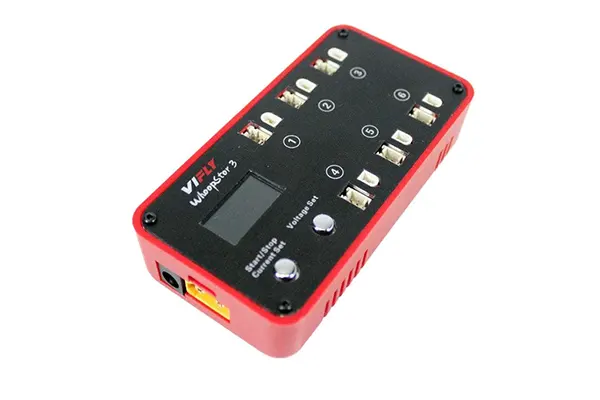
This is, hands down, my personal favorite Whoop battery charger today. It charges up to six packs at once. It can be powered off of USB-C, barrel plug, or XT60, so you can use your big flight packs (up to 6S voltage) to charge your Whoop packs if you’re away from power. It has both PH2.0 and BT2.0 plugs. It charges both standard lipo and HV lipos, but all ports must use the same type–no mixing. And it charges at up to 1.3 amps per channel, so you can hit 2C or even 3C on your batteries if you need to get up in the air quickly.
But the single feature that puts this charger over the top for me is that it has storage mode! Lipos hate being left at full charge or empty for long periods of time. Most lipo chargers have a storage mode, which puts the packs at a safe 3.8v / cell so they can be stored for a long time without damage. But Whoop chargers don’t have this. So your Whoop packs get left fully charged (or empty) and before you know it, they’re worn out. With the Whoopstor, you can put your Whoop packs to storage voltage, the same as you do with your larger packs, and extend their life.
GetFPV
RaceDayQuads
NewBeeDrone
Rotor Riot
Series Charging Boards
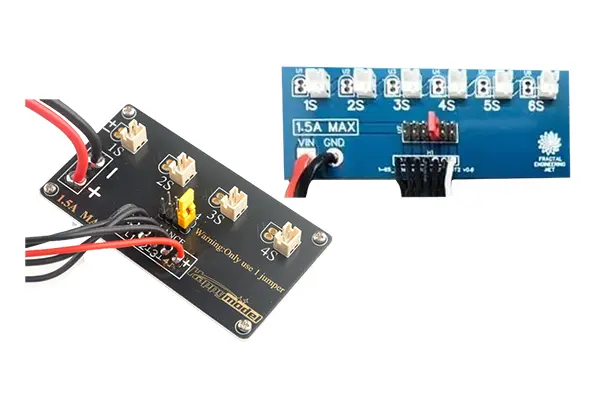
Let’s get one thing straight: These are NOT battery chargers. They’re series charging boards that let you easily charge your Whoop packs on your big-battery charger. Plug in your Whoop packs to the board. Plug the board into your charger as if it were a regular battery. The charger will auto-detect the number of “cells” (Whoop packs) plugged in, and then you can charge, discharge, and storage charge, just like normal. The charger will top off and balance the “cells”, and at the end of the cycle, you’ll be left with all the packs at whatever voltage you desire.
There are some quirks to this method, and many people prefer a simple set-and-forget dedicated Whoop battery charger. But these series boards offer functions like discharge and storage charge that most Whoop chargers leave out.
The Happymodel board supports only up to four packs at a time, while the Fractal Engineering board supports up to six.
The Fractal Engineering board sold at WeBleedFPV is the only one of these that comes with the BT2.0 plugs installed. The others have empty spots where you can solder your own BT2.0 plugs, but you have to source them and solder them yourself.





